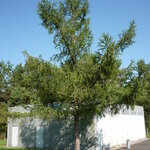Environment

Sitting in a balcony facing a forest in the apartment of our daughter I wonder where the botanists have gone. In our times it was common site to see lots of botanists tracking the woods and documentating the plants. Our teachers like Professor P D Sharma Professor K K Sharma Professor Shiv Sharma and Professor Uma Kant had great fascination of taking students to forests for collection They themselves have studied botany with Professor Kashyap , Professor Mehra, Professor Maheshwari and Professor Johari. Royal Botanical Garden Kew England had a list of…

If you look at the Pines sitting in your balcony you will wonder why they growth taller and taller and their apex moves towards the sky in straight line. You can see apical dominance. What provides apical dominance. Plants produce growth regulators on or near apical regions of roots as well as shoots and transfer it to the basipetal or acropetal pattern down from stem apex and up from root apex by certain mechanism which is highly croordinated using a set of genes which I have not been able to comprehend how do they work using different signal transduction systems. Let us understand in…

Palace of winds or Hawamahal of Jaipur is one the landmark or monuments. If you climb up the monument you can see the Nahargarh fort or Tiger fort once den or tiger is now a barren hills . Hope some day world heritage site or UNESCO will care for hills also.

Janter Manter of Jaipur is now world heritage site but what about hills of Jaipur.
Most of plants are cut and taken away as headloads by women for fuel.
Termite attack is destroying large number of Anogeissus plants. Once the ground flora is dried up the big trees are affected. Head loads of wood being taken away.

A view of Jaigarh fort from the Amber fort of Jaipur tells the untold story written on the hills, barren hills with no vegetation. As a botanist one may cry but how many of are us botanists nowMost botanists have become molecular biologist and biotechnologist and plants are crying.

Some of the most scenic views in the world can be had from Eiffel tower.

Ocimum basilicum is closely related to Ocimum canum and has great medicinal properties in traditional medicine. Each home in India was supposed to have this plant in their courtyard and worship Ocimum spp. They had insect repellent properties. I remember to have planted lots of Ocimum plants near water tap im my garden in Jaipur India which have multiplied to several plants . I dont know if it could be correlated with Ocimum or not but one thing is certain I never had dengu living in India for last 25 years or the period from which we had these plants raised in our garden. One thig is…

Beaches are to be kept clean. I witnessed beach of Barcelona. It was first time I visited a beach outside developing world. It was very different experience to see people relaxing as they please . Water was clean . No polythenes floating. No canes swimming . People kept the beaches clean . Wish all the beaches world over would be as clean as in Barcelona but I have yet to see some others to compare.

Sunflower is sign of luck in Germany, at least as my late Professor Dr Karl-Hermann Neumann told me on visit to his home in Hungen near Giessen in state of Hessen of Germany. He was leading a peaceful life in woods of Hungen after retirement . He invited me to his place and took me to a restaurant. It was written on the wall opposite a bench " Die hier sitzen, immer hier sitzen " I am not able to give exact words but it meant " Those who sit hier always sit here" I visited the restaurant again this summer and felt that he is still sitting there though he passed away in 2009.…

As against the common belief out of 16 families showing C 4 type of photosynthesis ( in some of their plant species ) mainly found in tropical plants where initial carbon acceptor is Phospho enol pyruvate carboxylase and first stable product is Oxalic acid acid Malate , 15 families are of dicotyledonous plants and only one family of monocot i.e. Graminae has this type of photosynthesis. Only Euphorbiaceae has all the three types of photosynthesis in their plant spp. Chenopodiaceae and Amaranthaceae are two important families having C 4 plants which are…